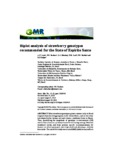Use este identificador para citar ou linkar para este item:
http://biblioteca.incaper.es.gov.br/digital/handle/item/2483Registro completo de metadados
| Campo DC | Valor | Idioma |
|---|---|---|
| dc.contributor.author | COSTA, A. F. da. | pt_BR |
| dc.contributor.author | TEODORO, P. E. | pt_BR |
| dc.contributor.author | BHERING, L.L. | pt_BR |
| dc.contributor.author | LEAL, N. R. | pt_BR |
| dc.contributor.author | TARDIN, F. D. | pt_BR |
| dc.contributor.author | DAHER, R. F. | pt_BR |
| dc.contributor.other | Andrea Ferreira da Costa, Incaper; UFV; UFV; UENF; Embrapa Milho e Sorgo; UENF. | pt_BR |
| dc.date.accessioned | 2016-11-29T12:57:15Z | - |
| dc.date.available | 2016-11-29T12:57:15Z | - |
| dc.date.created | 2016 | pt_BR |
| dc.date.issued | 2016-11-29 | pt_BR |
| dc.identifier.other | 14215 | pt_BR |
| dc.identifier.uri | http://biblioteca.incaper.es.gov.br/digital/handle/item/2483 | - |
| dc.description | Most strawberry genotypes grown commercially in Brazil originate from breeding programs in the United States, and are therefore not adapted to the various soil and climatic conditions found in Brazil. Thus, quantifying the magnitude of genotype x environment (GE) interactions serves as a primary means for increasing average Brazilian strawberry yields, and helps provide specific recommendations for farmers on which genotypes meet high yield and phenotypic stability thresholds. The aim of this study was to use AMMI (additive main effects and multiplicative interaction) and GGE biplot (genotype main effects + genotype x environment interaction) analyses to identify high-yield, stable strawberry genotypes grown at three locations in Espírito Santo for two agricultural years. We evaluated seven strawberry genotypes (Dover, Camino Real, Ventana, Camarosa, Seascape, Diamante, and Aromas) at three locations (Domingos Martins, Iúna, and Muniz Freire) in agricultural years 2006 and 2007, totaling six study environments. Joint analysis of variance was calculated using yield data (t/ha), and AMMI and GGE biplot analysis was conducted following the detection of a significant genotypes x agricultural years x locations (G x A x L) interaction. During the two agricultural years, evaluated locations were allocated to different regions on biplot graphics using both methods, indicating distinctions among them. Based on the results obtained from the two methods used in this study to investigate the G x A x L interaction, we recommend growing the Camarosa genotype for production at the three locations assessed due to the high frequency of favorable alleles, which were expressed in all localities evaluated regardless of the agricultural year. | pt_BR |
| dc.language | pt_BR | pt_BR |
| dc.publisher | Genetics and Molecular Research, v. 15, p. 1-9, 2016. | pt_BR |
| dc.subject | Fragaria x ananassa | pt_BR |
| dc.subject | Genotype x environment interaction | pt_BR |
| dc.subject | Yield | pt_BR |
| dc.subject | Strawberry | pt_BR |
| dc.title | Biplot analysis of strawberry genotypes recommended for the State of Espírito Santo. | pt_BR |
| dc.type | -- | pt_BR |
| dc.ainfo.id | 13410 | pt_BR |
| dc.ainfo.lastupdate | 2016-11-29 | pt_BR |
| dc.ainfo.depositante | Merielem Frasson | pt_BR |
| Aparece nas coleções: | Memória Técnica do Incaper  | |
Arquivos associados a este item:
| Arquivo | Descrição | Tamanho | Formato | |
|---|---|---|---|---|
| BRT-biplot.pdf | 1,01 MB | Adobe PDF |  Visualizar/Abrir |
Os itens no repositório estão protegidos por copyright, com todos os direitos reservados, salvo quando é indicado o contrário.
